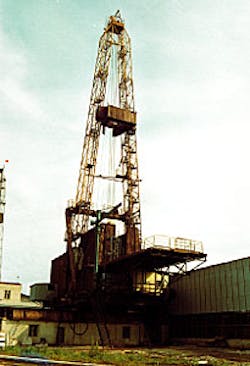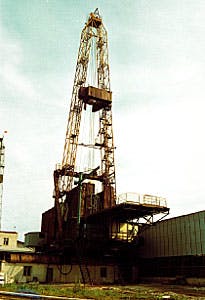Russian test facility allows direct inspection of bottom-hole assemblies under in situ conditions
Dean E. Gaddy
Drilling Editor
This Uralmash 300 EYK drilling rig is situated atop a 50-m deep bottomhole assembly test shaft in Perm, Russia (Fig. 1)
- The upper section of the pressure chamber (first level), located next to the elevator, is part of a closed-loop system connected to a hydraulic compensator on the right. The compensator creates pressure on the back side of the pressure chamber, maintaining the desired hydrostatic pressure in the hole (Fig. 3 [40,620 bytes]).
- The central control room uses computer monitoring and control equipment to operate and record test activities (Fig. 4 [21,351 bytes]).
- The rock chamber, to be installed in the lowest level of the test shaft, uses a heating coil wrapped around the chamber body and a hydraulic rock piston to simulate in situ drilling conditions (Fig. 5 [19,512 bytes]).
The high-pressure, high-temperature (HPHT) test site was constructed by the Perm Branch of the Scientific Production Amalgamation-Burovaya Tehknika (Vniibt) in cooperation with the St. Petersburg Institute of Rock Geomechanics and Survey (Vnimi).
According to Nikolai D. Derkach, general director for the research company Neftegastechnika and former Vniibt branch director, "this is the only facility in the world where the entire BHA can be directly examined under simulated drilling conditions." The site's principal components include:
- A Uralmash 3000 EYK drilling rig with a 130 metric ton load-carrying capacity ( Fig. 1 [19,322 bytes])
- A 50-m deep, 6-m wide mine shaft containing 15 levels accessible by elevator and stairs (Fig. 2 [102,435 bytes], left-hand side)
- A 50-m long, 300 mm ID pressure chamber (Figs. 2 and Fig. 3 [40,620 bytes])
- Computerized control center (Fig. 4 [21,351 bytes]).
The rock chamber can be exposed to axial and lateral pressures and vibrations while a heating coil wrapped around the outer section provides temperature variations (Fig. 5 [19,512 bytes]).
"A variety of rock types, downhole motors [positive displacement motors, turbodrills, electrodrills], drill bits, core recovery tools, and other equipment can all be experimented with interchangeably," Derkach said. In addition, the behavior of porosity, gas and moisture permeability, and elastic rock properties can also be measured.
Some recent tests at the site include high-temperature experiments, exceeding 200° C., on gear-reduction turbodrills designed for offshore Brazilian horizontal-drilling applications.
Copyright 1998 Oil & Gas Journal. All Rights Reserved.

